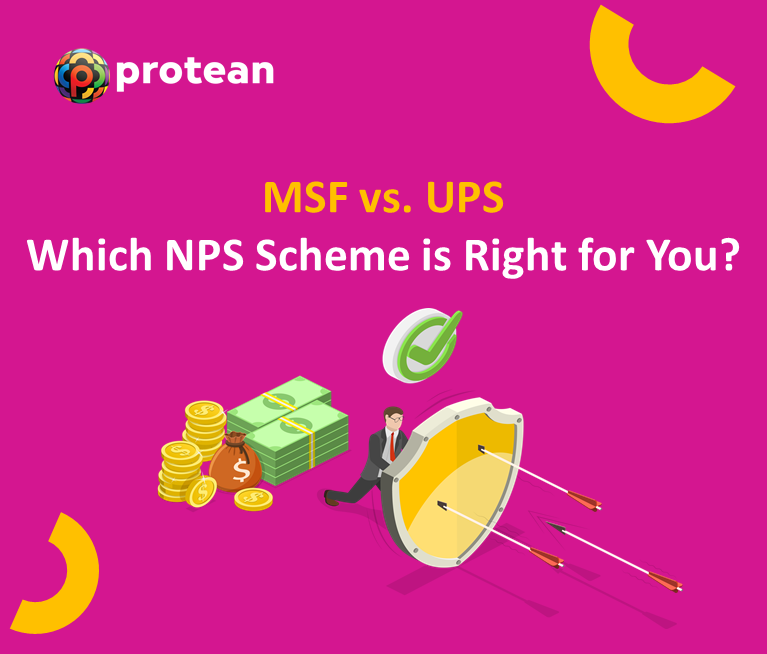While the Multiple Scheme Framework (MSF) under NPS and the Unified Pension Scheme (UPS) are both major recent changes in India’s pension landscape, their target audiences, core benefits, and underlying design principles are very different. For non‑government NPS subscribers—including private‑sector employees, corporate NPS subscribers, and self‑employed professionals—understanding how MSF differs from government‑employee schemes like UPS is important for informed retirement planning.
The Multiple Scheme Framework is a new design under NPS that offers non‑government subscribers greater choice and additional market‑linked investment options within their existing NPS account. The Unified Pension Scheme is an alternative system designed primarily for government employees who seek a guaranteed pension.
This guide breaks down the core differences and explains why the Multiple Scheme Framework (MSF) is a key new feature that non‑government NPS subscribers should carefully evaluate.
Defining the Core
While both frameworks operate under the regulatory umbrella, they serve vastly different objectives:
| Feature | Multiple Scheme Framework (MSF) | Unified Pension Scheme (UPS) |
|---|---|---|
| Primary Target Audience | Non-Government Subscribers (NGS): Private/Corporate Employees, Self-Employed, All Citizen Model. | Central Government Employees (primarily those previously under NPS). |
| Pension Philosophy | Defined Contribution (Market-Linked): Returns are based on market performance of chosen funds. | Defined Benefit (Guaranteed): Provides a minimum assured pension amount with reference to salary and qualifying service, ensuring predictable monthly payouts. |
| Investment Flexibility | High: Allows choice of multiple schemes, fund managers, and up to 100% equity allocation. | Low/None: Investment decisions are centralized by the government to ensure the guaranteed payout. |
| Guaranteed Payout | No assured pension amount; returns are subject to market risks. | Yes, provides a guaranteed minimum pension (e.g., ₹10,000 per month) and inflation adjustments. |
| Lump Sum Withdrawal | Yes, up to 60% of the corpus can be withdrawn tax-free at retirement. | Limited or no lump sum withdrawal option; the scheme emphasizes assured monthly pension payouts. |
The Focus for Non-Government Subscribers
The Multiple Scheme Framework (MSF) is the most important development for anyone in the private sector using the NPS. It addresses the historical limitations of the NPS scheme by introducing unprecedented flexibility and customization.
Portfolio Customization through Multiple Schemes
The core of the MSF is the ability to hold multiple schemes under your single Permanent Retirement Account Number (PRAN).
- The Old Way: You were largely confined to a single investment plan (e.g., Active Choice) under a Pension Fund Manager (PFM), with an equity cap of 75%.
- The MSF Way: A single PFM can now offer multiple, distinct schemes (e.g., Aggressive, Balanced, Conservative). A non-government subscriber can now allocate new contributions across these distinct schemes within a single PFM or across PFMs, allowing tailored risk management. This allows for genuine diversification within a single regulatory vehicle.
The Equity Potential
For young professionals with a long investment horizon, the MSF’s high-risk variant is a significant draw. The framework allows for the launch of a new NPS scheme that can allocate up to 100% of the contribution to equity and equity-related instruments.
This removes the previous 75% cap, giving non-government subscribers the potential to generate substantially higher, market-linked returns over decades—an essential feature for long-term wealth creation that competes effectively with external investment options like mutual funds, while retaining NPS tax benefits.
Risk Profiles and Transparency
Under MSF, each distinct scheme has its own Net Asset Value (NAV), performance benchmark, and disclosure. This enhances transparency, allowing you to monitor exactly how your "Aggressive" scheme is performing versus your "Conservative" scheme, enabling better portfolio management decisions. The MSF transforms the NPS from a simple savings tool into a sophisticated, personalized investment platform.
Why the UPS is Generally Not Applicable to You (The Private Sector)
The Unified Pension Scheme (UPS) represents a move back toward a "defined benefit" model, which the government is implementing as an option for its own employees who were covered under NPS.
Employment Sector Lock
The UPS is explicitly targeted at Central Government employees covered under NPS, with limited extension to State Government employees only if their respective state government chooses to implement the scheme. It is not an option available to private-sector, corporate, or self-employed subscribers. Your access to market-linked, flexible retirement savings remains firmly anchored in the NPS scheme, now significantly enhanced by the MSF.
Fundamental Risk Difference
The core distinction is the risk profile:
- MSF/NPS: MSF/NPS involves market risk as your corpus depends on fund performance, offering potential for higher returns.
- UPS: UPS offers a defined benefit with minimum guaranteed pension, with the government managing the risk to ensure fixed payouts based on last average basic salary and qualifying service.
For the non-government subscriber, the goal is typically to maximize the accumulated corpus through market participation (which MSF enables), rather than relying on a fixed, defined benefit (which UPS provides to government workers).
Strategic Implications for Your NPS Scheme
The choice between MSF and UPS is not a choice for non-government subscribers; rather, the focus must be on maximizing the benefits of the Multiple Scheme Framework.
Review Your Allocation
If you are a young private professional, you should evaluate if a switch of your new contributions to one of the MSF high-equity schemes (up to 100% equity) is aligned with your long-term goals.
Embrace Diversification
Use the multiple scheme framework to create a balanced portfolio. For example, you can allocate 70% to a high-growth MSF equity scheme and 30% to a stable corporate debt (C) scheme offered by the same or a different PFM.
Leverage Tax Benefits
The enhanced NPS scheme under the MSF retains all the tax benefits under Sections 80C and 80CCD(1B) (the latter providing an additional ₹50,000 deduction over and above the ₹1.5 lakh limit, available under the old tax regime), and 80CCD(2) for employer contributions, making NPS a powerful wealth-creation tool.
The Final Note
The introduction of Multiple Scheme Framework (MSF) and the Unified Pension Scheme (UPS), underscores a vital moment in Indian pension planning. The MSF represents a revolutionary flexibility for non-government subscribers, while the UPS addresses the stability needs of Central Government employees by providing a defined benefit-type pension scheme.
This framework transforms the standard NPS scheme into a personalized, powerful investment tool. By enabling investors to hold multiple schemes and allocate up to 100% equity, the MSF offers unparalleled flexibility and growth potential, making it the essential choice for securing a large, market-linked retirement corpus.
Frequently Asked Questions (FAQs)
Q1: Is the Unified Pension Scheme (UPS) available to private sector employees?
No. The UPS is designed and implemented by the Central Government primarily for its own employees who were covered under the NPS scheme and is generally not available to private, corporate, or self-employed subscribers.
Q2. What is the main difference between MSF and UPS?
MSF enhances the existing market-linked NPS (Defined Contribution) by adding flexibility. UPS introduces a guaranteed, fixed monthly payout (Defined Benefit) primarily for government employees.
Q3. Can I get a guaranteed pension under the MSF?
No. The NPS scheme under the MSF remains market-linked; there is no fixed, guaranteed pension amount. The return depends on the performance of the funds you choose.
Q4. What is the maximum equity exposure under the MSF scheme?
Under certain high-risk schemes launched through the Multiple Scheme Framework, a non-government subscriber can now allocate up to 100% of their new contributions to equity, removing the previous 75% limit.

